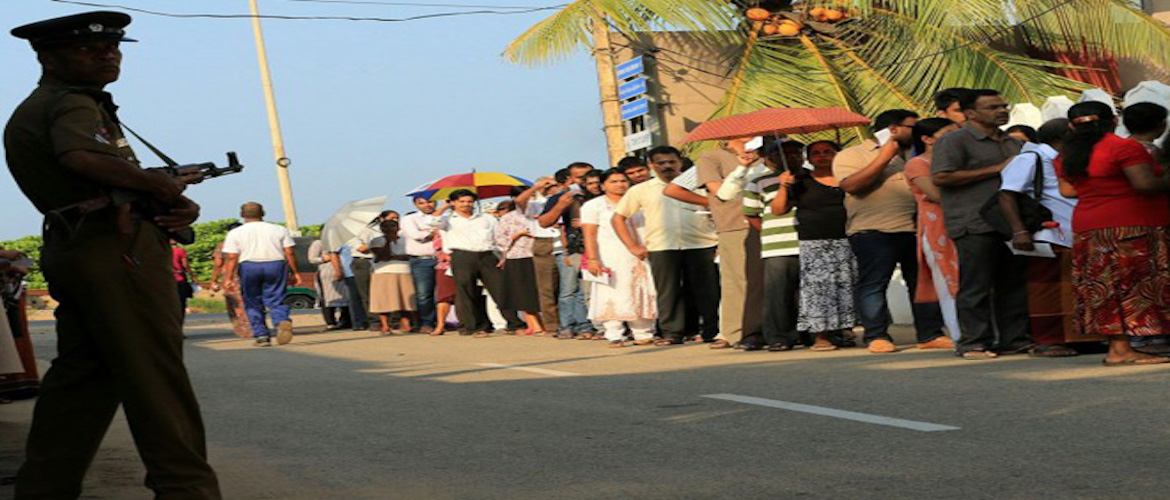Sri Lankan Elections
November 26, 2019 | Expert Insights

Background
Sri Lanka, or Ceylon as it was called in colonial times, has a long constitutional history going back to 1833 when executive and legislative councils were set up along with the opening up of the British civil services to Ceylonese.
Ceylon was granted self-governance in 1946, under a new constitution, with a bicameral legislature (which later became a single chamber). In 1948, Ceylon became fully independent and joined the Commonwealth.
The first Prime Minister was DS Senanayake, a leader of the independence movement and head of the United National Party (UNP). The UNP was supported by the Tamil Congress.
In 1951, the UNP underwent a split and SW Bandaranaike formed the Sri Lankan Freedom Party (SLFP). SLFP came to power in 1956 but lost their founder SW Bandaranaike to an assassination in 1959. A year later with a second consecutive election victory, SLFP was led by Bandaranaike’s widow who became the first woman Prime Minister in the world. UNP was voted back to power in 1965 under Dudley Senanayake and remained in power till 1970.
When Bandaranaike's SLFP government came back to power in 1972, the country's name was changed from Ceylon to Sri Lanka. Lanka means island and Sri means resplendent or venerable. In 1978, a constitutional amendment under the government of JR Jayewardene introduced an executive presidency.
Analysis
Gotabaya Rajapaksa is greatly admired by Sri Lanka’s ethnic majority for his role in ending the Tamil civil war but dreaded by minorities for his ruthless approach. He registered a convincing victory in the nation’s presidential election winning 52.25% of the vote versus his opponent Sajith Premadasa’s 48%.
The campaign and the subsequent results amplified deep ethnic and religious polarization in a country that has seen decades of conflicts and bloodshed along sectarian lines since independence from the British in 1948.
Gotabaya is credited with having masterminded a successful military campaign to wipe out LTTE, one of the most feared terrorist outfits in the world in 2009 and end a 30-year civil war. Thus, he is adored by most Sinhalese.
Mr Rajapaksa, 70, monikered “Terminator” by his family, profited on public outrage at the previous government’s failure to act decisively on Indian provided intel received of the terrorist attacks perpetrated in April by a Muslim militant group claiming loyalty to the Islamic State. The serial bombings, meticulously planned and executed, killed several hundreds of people in coordinated suicide bombings at churches and hotels on Easter Sunday.
In a clearly symbolic gesture of Sinhala pride, Mr Rajapaksa made his maiden speech after the electoral win at the iconic Ruwanveliseya Buddhist temple in the historic city of Anuradhapura. Pointing out the stupa which epitomised a 2500 years old Sinhala civilisation, he promised his supporters that he would be the bulwark of this proud Sinhalese Buddhist heritage.
Counterpoint
The new ruling dispensation faces a rocky road ahead. Gotabhaya is dogged by a number of human rights lawsuits which had threatened to foreclose his run for the presidency. Internationally, too, he is under a cloud for his role in the alleged human rights violations during the closing phase of the Tamil insurgency.
On his part, Gotabhaya has described Sri Lanka's commitment to a UN human rights agenda for reconciliation and accountability for alleged atrocities in the civil war as illegal.
Economically, the worldwide fall in demands is adversely affecting Sri Lanka’s export-oriented economy. Gotabhaya, who is considered close to China, will have to deal with a rising foreign debt which stands at 45% of the GDP. A quarter of this is owed to China. Among the projects built using Chinese financing are the now-infamous deep water port and airport in Hambantota, the Rajapaksa clan’s stronghold, a bone of contention with its closest neighbour, India.
Assessment
- Sri Lanka has witnessed one of the most peaceful presidential elections in the history of the independent republic. In the last five years, as a result of the democratic gains and institutional reforms, the independent elections commission has been empowered and the rule of law restored.
- Gotabaya Rajapaksa has won this election by leveraging the same hard-line approach to national security and “social discipline” that has propelled populists/nationalists to power around the world.
- There are fears that the electoral promises of the new government may possibly fuel ethnic tensions like the one that led to the Tamil insurgency. Reportedly military personnel detained for running an extortion/abduction ring in the pretext of counter-terrorism operations are being released. This will not go well with the minorities.
- Today Sri Lanka is a deeply polarised society with a clear divide between the Sinhala Buddhist majority and the minorities. Closing this divide is a huge challenge and would require understanding, tact and maturity.
- The largest debt instalments are due in 2021 and 2022 which is not very far. The new government will need to focus both on national security and strengthening the economy.
- Sri Lanka can become the next Asian Tiger. Half of the world's merchant fleet capacity and forty per cent of seaborne oil pass through Sri Lanka's southern coast making it one of the world's most important economic arteries.
India Watch
Sri Lanka-China relations are deeply entrenched due to the huge infrastructure investments made by China which India cannot match. However, India is critical to Sri Lanka’s security, a fact very well known to Gotabaya, who is a pragmatic leader and has stated in his manifesto to further develop security equations with its giant northern neighbour.
Economically also Indian business is important. Chinese promoted Colombo International Financial Centre, a self-contained smart city project, will open for business next year. It would be good business sense to seek Indian participation in this venture which could be mutually beneficial to both neighbours.
Image Courtesy: orfonline.org








Comments